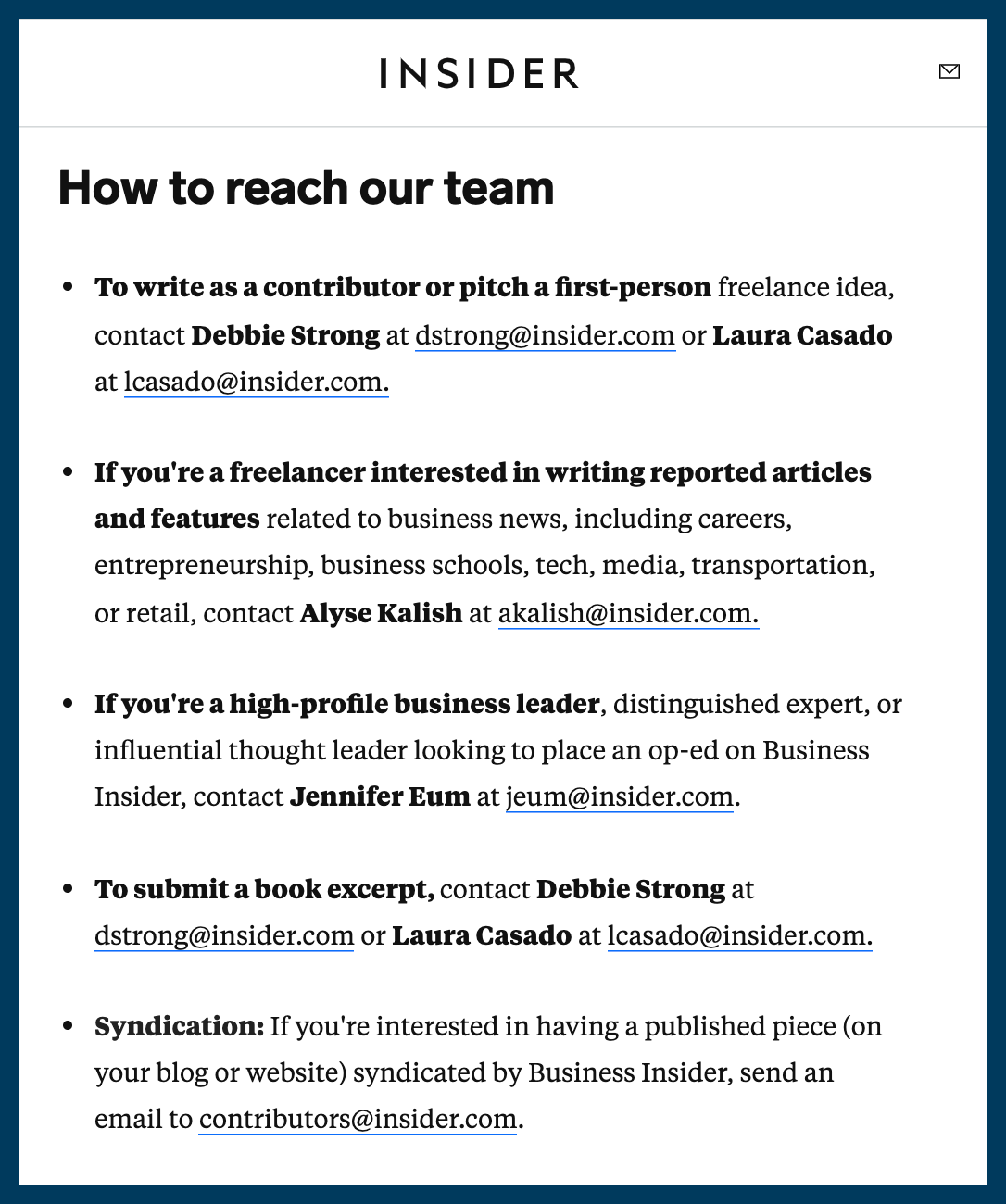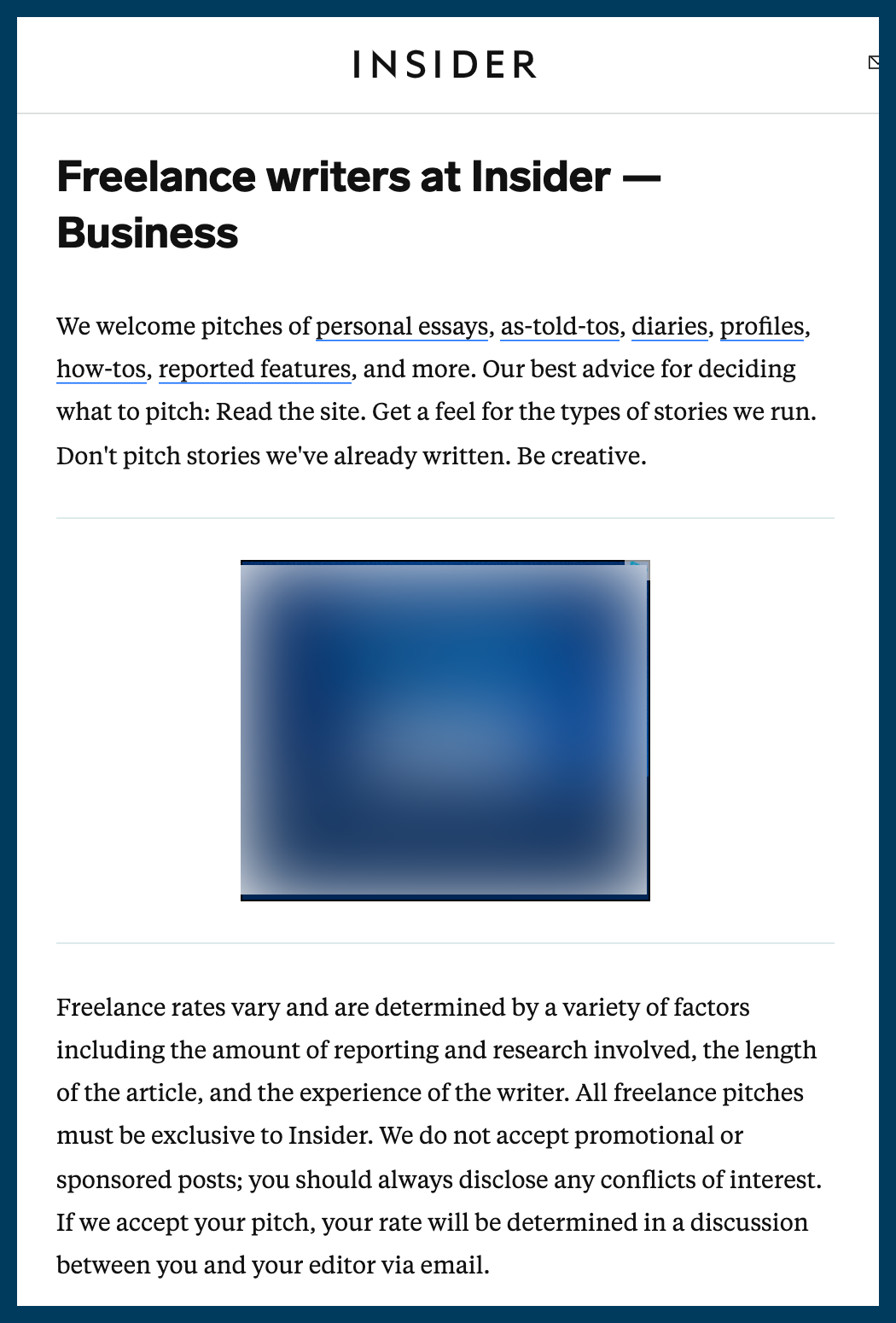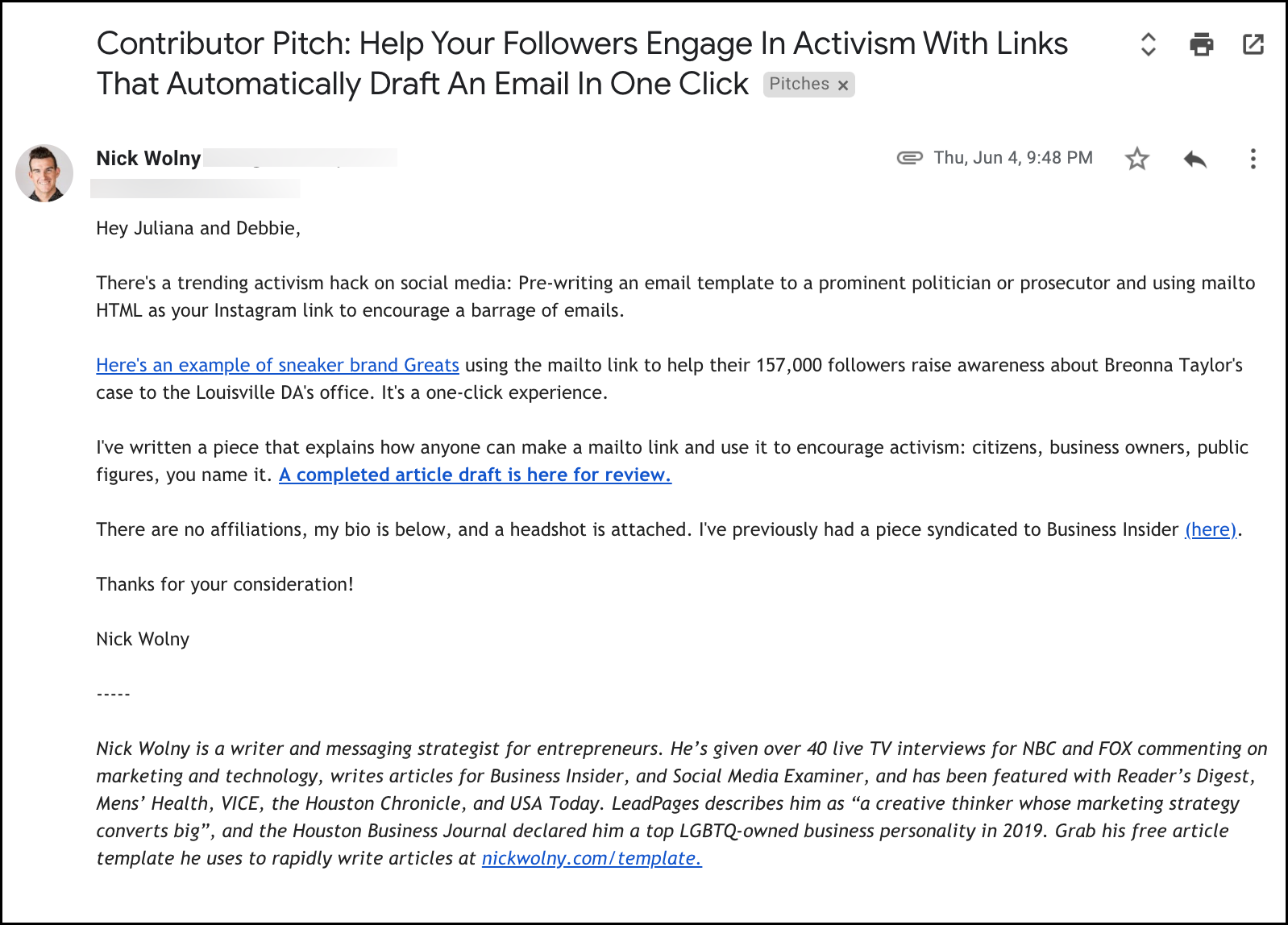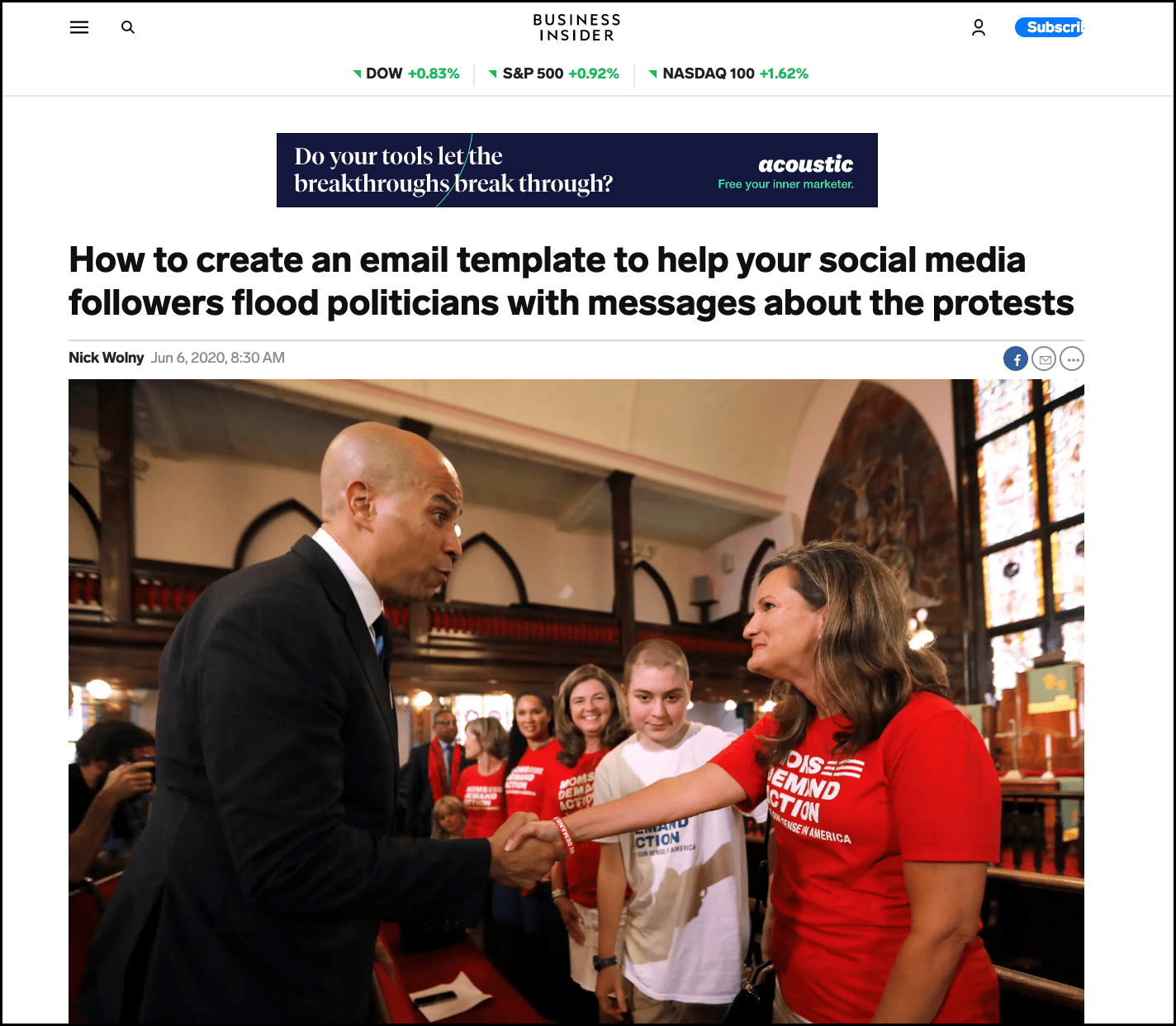Are you wondering how to contribute to or be featured in Business Insider – or other big publications?
Would the chance to get your expertise in front of hundreds, thousands, or millions of people for free help you reach your goals?
Cracking how to write for Business Insider and other traditional media outlets can give your personal brand or online business a huge lift in credibility, and these days you no longer need a publicist to start securing placements.
Key Takeaways
- The parent brand is called "Insider." Both refer to the publication interchangeably.
- Submitting a contributed article is different from submitting a pitch as a paid freelancer.
- Articles in Business Insider are often syndicated to several other outlets, helping you rack up those valuable media logos.
I've written and had articles syndicated to Business Insider several times. In this post I'll show you everything you need to know to get started.
Why Care About Writing for Business Insider?
With a domain authority of 94 (out of 100) and over 114 million site visits a month in 2020, Business Insider is one of the most prominent media properties on the web. A full placement or feature in Business Insider means opportunity for visibility, credibility, and exposure.
Business Insider is also one of the rare media properties that allow experts, authors, and entrepreneurs to pitch themselves directly to the outlet for consideration. Editors at many tier-one media outlets will only consider pitches from publicists, PR agencies, or well-established professionals. Business Insider welcomes commentary and pitches from writers of all levels.
Important:Anyone can pitch Business Insider; you don't have to be a media or PR professional.
If you don’t yet have any big media hits, or you’ve recently pivoted in your business and want to shout your glow-up from the rooftops, writing for Business Insider would be a great goal.
Let’s dissect what Business Insider says they’re looking for.
What Business Insider Says They Want from You
When an outlet actively wants writers to pitch, they often put together a “how to write for us” page. That’s the case for Business Insider as well; their write for us page is here.
The outlet even gives you the exact email addresses of the editors to pitch! So often we think the hardest part of media is knowing who to pitch; you'd be surprised how easy it is to find a gatekeeper's contact information with a little digging.
Here's a screenshot of that page's details.

A screenshot of Insider's "how to write for us" page.
There are several different types of placement opportunities for Business Insider; let’s go through each in a bit more detail.
Contributed articles and features
Most people are pitching either a contributed article or a first-person feature. In both cases, you wrote the article.
A contributed article is unpaid and shows out thought leadership and/or industry expertise.
A first-person feature can be paid or unpaid and zeroes in more on a personal experience. Think “How I Did It" articles.

Paid freelancing
If you’re a skilled freelancer or journalist, you could offer to write for Business Insider. In this scenario, your articles won’t be about you or your knowledge; you’ll be interviewing others and reporting on news or trends.
For coaches, consultants, creators, and online entrepreneurs, contributed articles and features are usually preferred, because you get to show off your smarts and industry know-how.
If you’re looking to get paid to write, however, freelancing might be a better option.

Instructions for writers who want to be paid for their submissions. These are more competitive.
Op-eds and commentary
An op-ed – short for opinion editorial – focuses on commentary about current events. It is an opinion piece, and for an outlet to back you, you need to already have a high profile.
Opinion pieces are more about perspective, and at larger media outlets you’l be expected to back up your arguments with citations and statistics.
Book excerpts
If you’ve written a book, you can submit an excerpt for publication consideration. Your excerpt should be compelling and be able to stand on its own as an article.
Syndication
If you have excellent blogs already floating around on the internet, you could submit them to Business Insider for consideration.
Additionally, sometimes Business Insider will syndicate an article of yours that was published elsewhere without you knowing it. My articles for Entrepreneur magazine are sometimes syndicated to Business Insider, and articles on Medium are sometimes syndicated as well.
You don’t have control over this syndication piece, but if you think your article from elsewhere has syndication potential, you could submit it for consideration.
Overview: My Exact Pitch for Business Insider
This article was completed and pitched on a Thursday night, accepted on a Friday morning, and published on a Saturday morning.
This is unusually quick, but every outlet varies, and contributed article pitching often goes faster because the draft is done from day one.
Some reasons I broke through when it came to writing for Business Insider were that my article draft was already written, I picked a very timely topic, I did my homework, and I made it as easy as possible to cut down on the back and forth with prospective editors.
Important:Having a simple media kit, such as a Google Drive folder with bio and headshot options, can cut down on back-and-forth with gatekeepers.
No secrets here — this is the email I sent.

A screenshot of my pitch to Business Insider, with email addresses redacted. The most-updated person to email will be on Insider's write for us page.
A good pitch is short, to the point, and strategic. This pitch seems fairly innocent, but actually has strategy and research laced in at various points.
It’s important to make your pitch custom, thoughtful, and unique. Remember: There's a person on the other side of the internet wading through dozens or even hundreds of pitches each day.
Here is a screenshot of the finished article, for reference.

Editors will usually workshop a headline and choose a featured image on their end — don't worry about getting these things perfect in your submission.
Next, let’s pick apart the 3 steps you should take to maximize chances for success.
Step 1: Research What the Outlet Is Looking For
Most media outlets actually want you to pitch them.
Some outlets are traditional media publications, which have the advantage of being a household name. Other outlets are niche websites that cater to a specific, unique audience.
Psychiatrists have Mad In America. Online business people have Smart Passive Income. There are many publication opportunities! Take a moment and ask yourself who you really want to be in front of.
Often, a smaller publication that has your exact target audience is just as powerful as landing a placement with a big tier-one outlet.
Poke around on the site
Spend some time looking at what’s actually getting published for a particular outlet.
Are some of the articles responding to current events? Are there particular topics being covered repeatedly? These are clues that can give you information on what to write about.
Important:Editors like it when you specify why your pitch or article would be a good fir for their publication. It shows you've done your homework.
You could write the next Moby Dick, but if you haven’t delivered what the outlet is asking for in the way they’re asking for it, you’ll be rejected or flat-out ignored.
Step 2: Write a Killer Article
I know, I know - this is a pretty big step two, and it's easier said than done. This is why it's important to hone your writing skills regularly and consistently.
More and more outlets that publish contributor and opinion articles now want to see an already-written article draft and a strong headline included in your pitch. Learn to write articles faster and this process will become painless over time.
In its simplest form, I follow a three-draft approach to producing articles.
➡️ The first draft is a free-write. It's a race to get to 1,000 words or more as quickly as you can, and is also usually a steaming pile of garbage. That's okay (for now).
➡️ The second draft is a series of "surgeries" in which you comb through your freewritten mess and sharpen up your argument.
➡️ The third draft is more about polish, word choice, and rhythm. Also use this draft to add some personality. If writing for your blog, you could throw in graphics or visuals here as well.
Each draft feels very different. It’s important to practice all three drafts and identify which draft stage you’re in as you write. Otherwise, you’ll have a hard time establishing a regular routine.
Step 3: Make It Easy to Say Yes to Your Pitch
It’s time to pitch! I like to include everything an editor or gatekeeper might need or want in order to publish the article immediately. Remember: They told you they needed these items on the "write for us" page.
Including this information in your pitch upfront cuts down on back-and-forth emails and can actually be the difference between your article getting published or getting lost in the mix.
Consider including the following information:
- A headshot and short bio. Attach a high-quality headshot and a media bio. Check to see what the bios look like for other contributors on the site.
- Past published writing samples. If you have past samples of published work, throw in a humble brag. This lets the editor know before they click to read your draft that your writing has been published before by other editors.
- Confirmation of any affiliations. You have to disclose any financial relationships you have with cited experts or resources in your articles.
Unfortunately, the last few years have seen a rise in contributors "selling" their platforms. I myself am pitched frequently by companies wanting to buy their way in to a feature; this is an editorial no-no.
Confirm from the jump that you have no financial ties to the content in the article.
The first few articles you pitch will take some practice. But over time, as you become accustomed to every step of the process, you’ll find yourself writing more, pursuing big outlets, and securing name recognition that can build up your brand over and over again. 🙌🏽
Thanks For Reading 🙏🏼
Keep up the momentum with one or more of these next steps:
📣 Share this post with your network or a friend. Sharing helps spread the word, and posts are formatted to be both easy to read and easy to curate – you'll look savvy and informed.
📲 Hang out with me on another platform. I'm active on Medium, Instagram, and LinkedIn – if you're on any of those, say hello.
📬 Sign up for my free email list. This is where my best, most exclusive and most valuable content gets published. Use any of the signup boxes on the site.
🏕 Up your writing game: Camp Wordsmith® is a free online resources portal all about writing and media. Get instant access to resources and templates guaranteed to make your marketing hustle faster, better, easier, and more fun. Sign up for free here.
📊 Hire me for consulting. I provide 1-on-1 consultations through my company, Hefty Media Group. We're a certified diversity supplier with the National Gay & Lesbian Chamber of Commerce. Learn more here.


